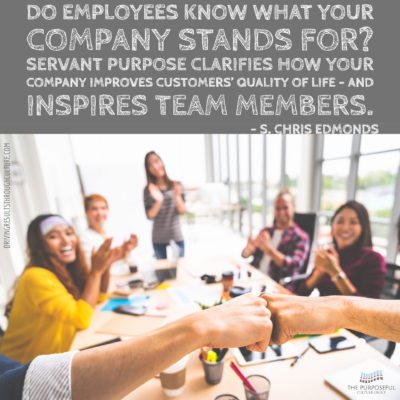What is your company’s servant purpose – its present day “reason for being”?
Most companies do not go to the length required to formalize their servant purpose and then communicate frequently to team members how their work contributes to that higher purpose.
Recent research from Gallup notes that only 4 in 10 US employees agree that they know what their company stands for and what makes it different from their competitors.
Higher purpose has been shown to boost company performance. A 2016 Harvard study found that companies with high purpose and high clarity from management systematically outperform companies with low purpose and low clarity.
A servant purpose statement has three elements. It states what your company does, for whom, and “to what end” – how what your company does improves customers’ quality of life.
In today’s three minute episode of my Culture Leadership Charge video series, I look at two different company’s purpose statements – one effective, one rather awful – and outline how to craft an effective servant purpose statement that inspires.
This is episode eighty-one of my Culture Leadership Charge series. Each episode is a 3-4 minute video that describes proven culture leadership and servant leadership practices that boost engagement, service, and results across your work teams, departments, regions, companies – and even homes and neighborhoods.
You’ll find my Culture Leadership Charge episodes and more on my YouTube and my iTunes channels. If you like what you see or hear, please subscribe!Shortcode
Have you responded to this month’s culture leadership poll? Add your perspective to two questions – it’ll take you less than a minute. Then click the “results” link to see what others from around the globe think!
Photo © Adobe Stock – sushiman. All rights reserved.




Hello, Chris. At 3M our corporate vision is “3M Technology Advancing Every Company; 3M Products Enhancing Every Home; 3M Innovation Improving Every Life.” I’m curious about your thoughts on how well this serves as a purpose statement. Is it clear enough on the “to what end” part? Or do you want to leave it open enough for different functions of the organization to apply the statement to their own environment? I also have a question of clarification. Are you suggesting the purpose statement should reflect the culture or does it drive the culture? Thank you for your insights.
Hey, Daniel! Great to hear from you.
Based on the servant purpose template I’ve used with client for years, 3M has not formally stated the “to what end,” the desired benefit to customers/consumers. 3M is a great company that I’ve written about in the past. I’ll bet there ARE clear customer/consumer benefits by division, maybe even across the company. Leaving it open doesn’t create clarity.
And – do 3M team leaders and team members believe they’re doing work that improves customers’ quality of life? Do they see that they’re doing meaningful work? Does 3M formally measure & monitor that data point?
What drives a purposeful, positive, productive work culture is alignment to a formalized organizational constitution – which includes servant purpose, values & behaviors, strategies and goals. Servant purpose alone won’t do that.
Helpful?
Yes, that is very helpful. Thank you. I do believe 3M has a culture that walks hand in hand with a sense of servant purpose.
🙏